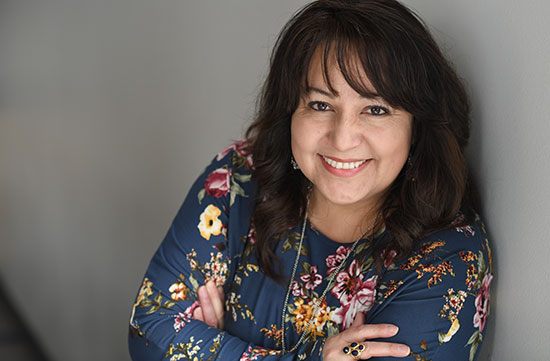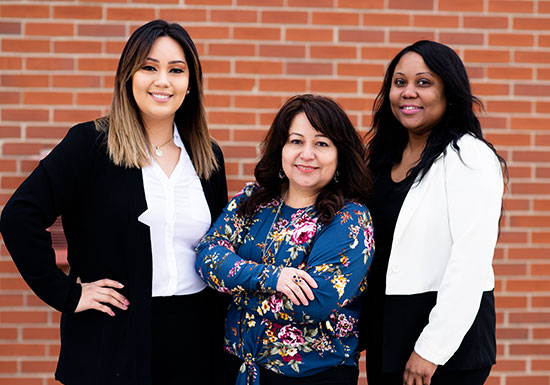
An important lesson about effectively representing people did not come from a law professor or treatise. It instead came from receptionist Veronica Vega, a champion for her community and the free Vera Court legal clinic on Madison’s north side. Photos: Tatiana Shirasaki Photography
An important lesson about effectively representing people did not come from a law professor or treatise. It instead came from the receptionist at the Vera Court Neighborhood Center on Madison’s north side. Her name is Veronica.
Several years ago, my company, Ascendium Education Group, established a free legal clinic at Vera Court. It was easy. We obtained template limited-scope-representation forms from a law firm. We coordinated an intake process with Vera Court’s receptionist. We distributed some fliers. And we have seen nearly 100 clients.
Excited by the Vera Court clinic’s success, we decided to set up a second clinic at a local school, thinking it would be just as easy and successful. We entered an agreement with the district. We met with the principal and office secretary. We publicized the clinic by sending home fliers in students’ backpacks and posting articles in the school newsletter. And then we waited … and waited … and waited. And we never got any clients. Not a one!
I was a bit puzzled at first. The school served the same community as Vera Court. Its families almost certainly faced the same massive constellation of legal needs. But I quickly realized what – or whom – we were missing: Veronica, our receptionist at Vera Court. Potential clients trust and confide in Veronica, and she spots people’s potential legal issues and connects them with us. The clinic would not be a clinic, but instead a stack of template forms and good intentions, without Veronica. We did not have anyone like Veronica, who not just allowed but truly championed the clinic, at the school.
Veronica taught me an important lesson. Though the justice gap is often talked about as a legal issue, it is not solely an issue for lawyers just as hunger is not solely an issue for cooks or homelessness an issue for contractors. The justice gap’s pernicious reach extends far beyond the legal community, and we attorneys must look outside our profession – to people like Veronica – to close it.
The Justice Gap is Huge and Complex
Our nation is founded on the principle that everyone is equal before the law. But this simply is not true. In a recent justice gap study commissioned by the Legal Services Corporation, University of Chicago researchers found that 86 percent of people have unmet legal needs. The number is even higher with certain groups such as domestic violence survivors, people with disabilities, veterans, and senior citizens.
 Rebecca Rapp, Chicago 2000, is general counsel and chief privacy officer at Great Lakes Higher Education Corp., Madison. She previously served as a Dane County Circuit Court judge and an assistant attorney general at the Wisconsin Department of Justice. This column is based on an address Rapp recently gave at a Wisconsin Equal Justice Fund dinner. The column reflects the author’s personal views, not those of Ascendium.
Rebecca Rapp, Chicago 2000, is general counsel and chief privacy officer at Great Lakes Higher Education Corp., Madison. She previously served as a Dane County Circuit Court judge and an assistant attorney general at the Wisconsin Department of Justice. This column is based on an address Rapp recently gave at a Wisconsin Equal Justice Fund dinner. The column reflects the author’s personal views, not those of Ascendium.
Given this enormity, the justice gap would be difficult enough to close if it were “just” a matter of providing attorneys to people who want and need them. But the problem is complicated by other factors, too – factors that make people outside the community like Veronica so important to helping people access the justice system.
Many individuals don’t know their problems are legal ones. People who have had bad experiences in the court system, criminal or civil, often view the entire legal system with suspicion. Undocumented immigrants might be reluctant to pursue their legal rights or question whether they have any at all. And people facing the everyday difficulties of being poor – low-wage, inflexible, hourly jobs and limited transportation or childcare – may not have time to access the justice system even if they wanted to.
People with unmet legal needs are left to either represent themselves, often ineffectively, or simply abandon any hope of having their legal needs met. And that’s if they even realize their problems are legal ones that have a legal solution.
The Justice Gap Causes Widespread Harm
The justice gap is a significant drag on the legal system. Our legal system was created by and for lawyers. People who do not have representation are often unable to access the legal system at all let alone in any meaningful way. Courts and clerks are ill-equipped and often struggle to provide an adequate forum for those who try to exercise their legal rights.
But the justice gap does not harm only the legal system. It also harms society as a whole. Unmet legal needs can set off a chain reaction. Leaving legal needs unmet undermines whatever stability the individuals facing them have achieved. Entire communities can be destabilized and individual problems can grow into societal ones, when all the unmet legal needs of the 86 percent of people facing them are combined.
The massive community-wide beneficial impact of fulfilling unmet legal needs is underscored by studies such as the Wisconsin Access to Justice Commission’s 2005 Access to Justice Report. This study documents a massive return – nine- or ten-fold or even more – for every dollar invested providing legal help to those who need it.

Intern Jasmin Loera-Espinoza, receptionist Veronica Vega, and paralegal Tomikca Jackson play an important role in closing the justice gap through the Vera Court Neighborhood Center’s legal clinic.
We Need More Veronicas to Close the Justice Gap
Lawyers no doubt have a vital role to play in closing the justice gap. We provide clients representation and other legal assistance after all. But the justice gap is simply too large and too complex for lawyers to close on our own. We must look outside the legal community to succeed.
As a preliminary matter, we need data scientists and others to help us understand the justice gap and the resources needed to close it. The Legal Services Corporation’s robust, empirically based Justice Gap Report illustrates this. It has been crucial for understanding the justice gap’s extensive scope and for highlighting the woeful inadequacy of the investment in civil legal services. We must use similar analytical rigor, not just from data scientists but also from experts in fields such as behavioral economics, sociology, and design thinking, to help figure out how to deploy our far-too-limited legal-services resources as effectively and efficiently as possible.
Ultimately, however, it’s not “merely” a matter of understanding the justice gap and of effectively securing and deploying resources. As Veronica taught me, the legal community could not close the justice gap on its own even if we could provide an attorney for everyone who needs one. We need champions and sponsors such as Veronica to get any clients at all.
Lawyers alone could not close the justice gap even if there were an attorney for everyone who needs one.
